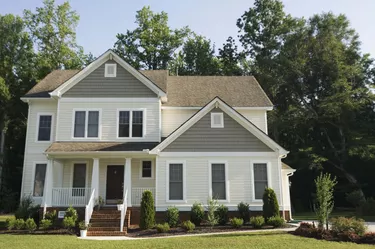
Mortgage lenders analyze your home's value before issuing a home equity line of credit. A HELOC works much like a credit card, making a portion of your home's equity available to use on a revolving basis. You can borrow from your available credit line up to a certain limit and pay down the balance to replenish your credit. Lenders order appraisals and set minimum inspection standards for HELOCs.
Minimum Appraisal Type Needed
Video of the Day
Your home serves as collateral for a HELOC, therefore lenders must ensure that your home's worth is sufficient to recover any outstanding balance should you fail to make payments. An appraisal allows lenders to "see" your home and determine whether its value and condition meet HELOC underwriting guidelines. Lenders may ask for a full appraisal by a certified or licensed appraisal company, a drive-by appraisal or a computerized appraisal method known as an automated valuation model, or AVM. The minimum appraisal type required depends on the loan amount and lender preference.
Video of the Day
Monetary Amounts Matter
The HELOC limit affects the minimum appraisal requirements a lender sets. For example, a HELOC of $250,000 or more is considered high-risk. Federal financial regulations require that lenders order full interior and exterior appraisal inspections for high-risk loans. HELOCs of lesser amounts that don't require walk-through appraisals may qualify for drive-by, exterior appraisal inspections or interior and exterior drive-by inspections, in which an appraiser visits the property but inspects less thoroughly. HELOCs of less than $250,000 may also qualify for an AVM or a "desktop" appraisal, in which an appraiser estimates value by researching available comparable property values and courthouse data.
Appraisal Determined by Lenders
Lenders choose the preferred appraisal method based on loan amount, cost, convenience and confidence. For example, a more stringent lender may require a full appraisal for HELOC amounts of more than $100,000. Smaller HELOC loans may only require a drive-by appraisal or an AVM. HELOCs typically have fewer closing costs and lenders often pay for AVMs, whereas borrowers pay for drive-by or full appraisal inspections. AVMs generate results quickly and cost only about $30 to $50, whereas full walk-through appraisals take several days and cost $350 or more.
A Warning About AVMs
The more concise appraisal option of an AVM is usually available only to HELOC applicants, as HELOCs are typically obtained through refinance as secondary forms of financing and not as primary mortgages, and for smaller amounts. However, "REALTOR Mag" reports that AVMs have led to valuation discrepancies because they lack the precision and rigorous standards of walk-through appraisal inspections. Although they may suffice for HELOCs, they can also result in values that are thousands of dollars off. That's because AVMs can't detect property defects such as a bad roof or details such as the number of cars a garage holds.